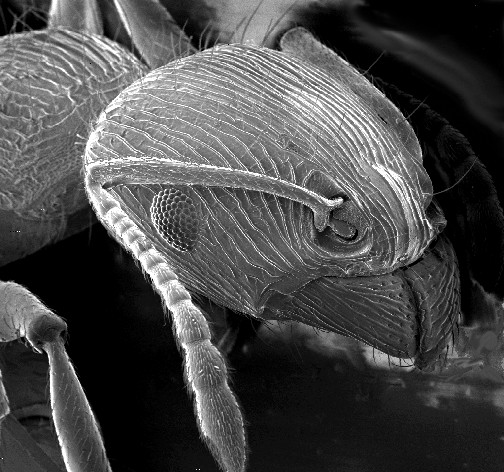Exoskeleton
 From Wikidoc - Reading time: 4 min
From Wikidoc - Reading time: 4 min
An exoskeleton is an external anatomical feature that supports and protects an animal's body, in contrast to the internal endoskeleton of, for example, a human. Whilst many many other invertebrate animals (such as shelled mollusks) have exoskeletons in the sense of external hard parts, the character is most associated with the arthropods (i.e. insects, spiders, myriapods and crustaceans). Exoskeletons contain rigid and resistant components that fulfil a set of functional roles including protection, excretion, sensing, support, feeding and (for terrestrial organisms) acting as a barrier against desiccation. Exoskeletons first appeared in the fossil record about 550 million years ago, and their evolution has been seen as critical as a driving role in the Cambrian explosion of animals that took place subsequent to this time.
Arthropod exoskeletons[edit | edit source]
Microscopic structure[edit | edit source]
A typical arthropod exoskeleton is a multi-layered structure with four functional regions: epicuticle, procuticle, epidermis and basement membrane.[1]. Of these, the epicuticle is a multi-layered external barrier that, especially in terrestrial arthropods, acts as a barrier against dessiccation. The strength of the exoskeleton is provided by the underlying procuticle, which is in turn secreted by the epidermis. Arthropod cuticle is a biological composite material, consisting of two main portions: fibrous chains of alpha-chitin within a matrix of silk-like and globular proteins, of which the most well-known is the rubbery protein called resilin. The relative abundance of these two main components varies from approximately 50/50 to 70/30 protein/chitin, with softer parts of the exoskeleton having a higher proportion of chitin. Although the cuticle is relatively soft when first secreted, it soon hardens in a poorly-understood process that involves dehydration and/or tanning mediated by hydrophobic chemicals called phenolics. Different types of interaction between the proteins and chitin leads to varying mechanical properties of the exoskeleton.
In addition to the chitino-proteinaceous composite of the cuticle, many crustaceans, some myriapods and the extinct trilobites further impregnate the cuticle with mineral salts, above all calcium carbonate, which can make up up to 40% of the cuticle. This can lead to great mechanical strength.
Organisation[edit | edit source]

The arthropod exoskeleton is typically divided into different functional units to allow flexibility in an often otherwise rigid structure. For example, the head is a fused capsule; and the trunk is often divided into a series of articulating sclerites called tergites. In addition, the characteristic limbs of arthropods need to be jointed. The internal surface of the exoskeleton is often elaborated into a set of specialised structures called apodemes that allow the attachment of muscles. Such endoskeletal components of the arthropod skeleton can be highly complex, as in crabs and lobsters.
Ecdysis[edit | edit source]
- See also main article: Ecdysis
The relative rigidity of the exoskeleton means that continuous growth of arthropods is not possible. Therefore, growth is periodic and concentrated into a period of time when the exoskeleton is shed, called moulting or ecdysis, which is under the control of a hormone called ecdysone. Moulting is a complex process that is invariably dangerous for the arthropod involved. Before the old exoskeleton is shed, the cuticle separates from the epidermis through a process called apolysis. New cuticle is excreted by the underlying epidermis, and mineral salts are usually withdrawn from the old cuticle for re-use. After the old cuticle is shed, the arthropod typically pumps up its body (for example, by air or water intake) to allow the new cuticle to expand to a larger size: the process of hardening by dehydration of the cuticle then takes place. Newly molted arthropods typically appear pale or white, and darken as the cuticle hardens.
Natural exoskeletons[edit | edit source]
Excellent as defensive adaptation, exoskeletons may nevertheless cause problems where entities carry an excessive weight to surface-area ratio or whenever organism growth requires an enlargement of the exoskeleton. Exoskeletons are found on many different types of organisms including shellfish and insects.
Types[edit | edit source]
- Bone and cartilage
- Ostracoderms (extinct armoured fish)
- Turtles, Terrapins and Tortoises
- Chitin
- Arthropods
- some Bacteria
- Calcium compounds
- Silicate
Artificial human exoskeletons[edit | edit source]
Humans have long used armour as an artificial exoskeleton for protection, especially in combat. Exoskeletal machines are also starting to be used for medical and industrial purposes, while Powered human exoskeletons are a feature of science fiction writing, but are currently moving into prototype stage. Orthoses are a limited, medical form of exoskeleton.
In history[edit | edit source]
Medieval armour (in the case of mounted knights) is not load-bearing, but furnishes the appearance of an artificial human exoskeleton.
In medicine[edit | edit source]
An orthosis (plural orthoses) is a device which attaches to a limb, or the torso, to support the function or correct the shape of that limb or the spine. Orthotics is the field dealing with orthoses, their use, and their manufacture. An orthotist is a person who designs and fits orthoses.
A limb prosthesis (plural prostheses) is a device that substitutes for a missing part of a limb. If the prosthesis is a hollow shell and self-carrying, it is exoskeletal. If internal tubes are used in the device and the cover (cosmesis) to create the outside shape is made of a soft, non-carrying material, it is endoskeletal. Prosthetics is the field that deals with prostheses, use, and their manufacture. A prosthetist is a person who designs and fits prostheses.
In modern and near-future technology[edit | edit source]
References[edit | edit source]
See also[edit | edit source]
- Mechatronics
- Spiracle - Small openings in the exoskeleton that allow insects to breathe
External links[edit | edit source]
Biology[edit | edit source]
Modern technology[edit | edit source]
- Bionic Boots
- PowerSkip
- Berkeley Lower Extremity Exoskeleton (BLEEX)
- University of Washington Exo Arm Project
ar:هيكل خارجي bg:Екзоскелет ca:Exosquelet de:Exoskelett el:Εξωσκελετός lt:Egzoskeletas nl:Exoskelet nn:Eksoskjelett no:Ytre skjelett sk:Exoskelet fi:Ulkoinen tukiranka sv:Exoskelett th:โครงกระดูกภายนอก
 KSF
KSF